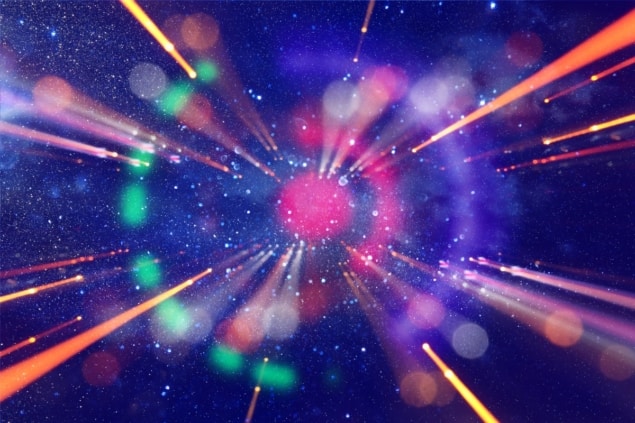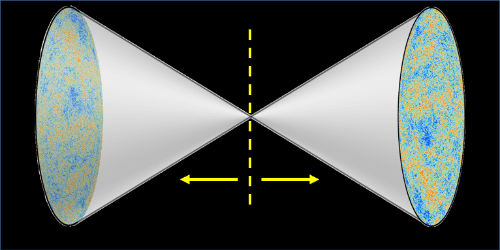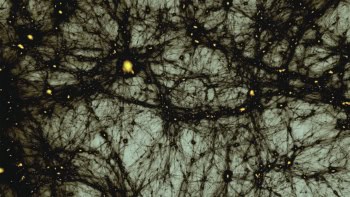
Our universe could be the mirror image of an antimatter universe extending backwards in time before the Big Bang. So claim physicists in Canada, who have devised a new cosmological model positing the existence of an “antiuniverse” which, paired to our own, preserves a fundamental rule of physics called CPT symmetry. The researchers still need to work out many details of their theory, but they say it naturally explains the existence of dark matter.
Standard cosmological models tell us that the universe – space, time and mass/energy – exploded into existence some 14 billion years ago and has since expanded and cooled, leading to the progressive formation of subatomic particles, atoms, stars and planets.
However, Neil Turok of the Perimeter Institute for Theoretical Physics in Ontario reckons that these models’ reliance on ad-hoc parameters means they increasingly resemble Ptolemy’s description of the solar system. One such parameter, he says, is the brief period of rapid expansion known as inflation that can account for the universe’s large-scale uniformity. “There is this frame of mind that you explain a new phenomenon by inventing a new particle or field,” he says. “I think that may turn out to be misguided.”
Instead, Turok and his Perimeter Institute colleague Latham Boyle set out to develop a model of the universe that can explain all observable phenomena based only on the known particles and fields. They asked themselves whether there is a natural way to extend the universe beyond the Big Bang – a singularity where general relativity breaks down – and then out the other side. “We found that there was,” he says.
The answer was to assume that the universe as a whole obeys CPT symmetry. This fundamental principle requires that any physical process remains the same if time is reversed, space inverted and particles replaced by antiparticles. Turok says that this is not the case for the universe that we see around us, where time runs forward as space expands, and there’s more matter than antimatter.

Instead, says Turok, the entity that respects the symmetry is a universe–antiuniverse pair. The antiuniverse would stretch back in time from the Big Bang, getting bigger as it does so, and would be dominated by antimatter as well as having its spatial properties inverted compared to those in our universe – a situation analogous to the creation of electron–positron pairs in a vacuum, says Turok.
Turok, who also collaborated with Kieran Finn of Manchester University in the UK, acknowledges that the model still needs plenty of work and is likely to have many detractors. Indeed, he says that he and his colleagues “had a protracted discussion” with the referees reviewing the paper for Physical Review Letters – where it was eventually published – over the temperature fluctuations in the cosmic microwave background. “They said you have to explain the fluctuations and we said that is a work in progress. Eventually they gave in,” he says.
In very broad terms, Turok says, the fluctuations are due to the quantum-mechanical nature of space–time near the Big Bang singularity. While the far future of our universe and the distant past of the antiuniverse would provide fixed (classical) points, all possible quantum-based permutations would exist in the middle. He and his colleagues counted the instances of each possible configuration of the CPT pair, and from that worked out which is most likely to exist. “It turns out that the most likely universe is one that looks similar to ours,” he says.
Turok adds that quantum uncertainty means that universe and antiuniverse are not exact mirror images of one another – which sidesteps thorny problems such as free will.

Cyclic universe could explain cosmological constant
But problems aside, Turok says that the new model provides a natural candidate for dark matter. This candidate is an ultra-elusive, very massive particle called a “sterile” neutrino hypothesized to account for the finite (very small) mass of more common left-handed neutrinos. According to Turok, CPT symmetry can be used to work out the abundance of right-handed neutrinos in our universe from first principles. By factoring in the observed density of dark matter, he says that quantity yields a mass for the right-handed neutrino of about 5×108 GeV – some 500 million times the mass of the proton.
Turok describes that mass as “tantalizingly” similar to the one derived from a couple of anomalous radio signals spotted by the Antarctic Impulsive Transient Antenna (ANITA). The balloon-borne experiment, which flies high over Antarctica, generally observes cosmic rays travelling down through the atmosphere. However, on two occasions ANITA appears to have detected particles travelling up through the Earth with masses between 2 and 10×108 GeV. Given that ordinary neutrinos would almost certainly interact before getting that far, Thomas Weiler of Vanderbilt University and colleagues recently proposed that the culprits were instead decaying right-handed neutrinos.
Turok, however, points out a fly in the ointment – which is that the CPT symmetric model requires these neutrinos to be completely stable. But he remains cautiously optimistic. “It is possible to make these particles decay over the age of the universe but that takes a little adjustment of our model,” he says. “So we are still intrigued but I certainly wouldn’t say we are convinced at this stage.”



